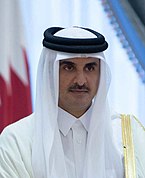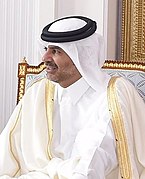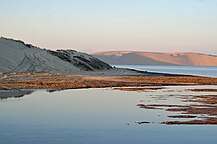
A | B | C | D | E | F | G | H | CH | I | J | K | L | M | N | O | P | Q | R | S | T | U | V | W | X | Y | Z | 0 | 1 | 2 | 3 | 4 | 5 | 6 | 7 | 8 | 9
State of Qatar | |
|---|---|
| Motto: الله الوطن الأمير Allāh al-Waṭan al-ʾAmīr "God, Nation, Emir" | |
| Anthem: السلام الأميري As-Salām al-ʾAmīrī "Peace to the Emir" | |
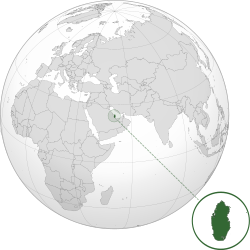 Location and extent of Qatar (dark green) on the Arabian Peninsula | |
| Capital and largest city | Doha 25°18′N 51°31′E / 25.300°N 51.517°E |
| Official languages | Arabic[1] |
| Ethnic groups (2019)[3] |
|
| Religion (2020)[4] | |
| Demonym(s) | Qatari |
| Government | Unitary authoritarian[5][6] parliamentary semi-constitutional monarchy |
• Emir | Tamim bin Hamad |
• Deputy Emir | Abdullah bin Hamad |
| Mohammed bin Abdulrahman | |
| Legislature | Consultative Assembly |
| Establishment | |
| 18 December 1878 | |
• Declared independence | 1 September 1971 |
• Independence from the United Kingdom | 3 September 1971 |
| Area | |
• Total | 11,581 km2 (4,471 sq mi) (158th) |
• Water (%) | 0.8 |
| Population | |
• 2020 estimate | 2,795,484[7] (139th) |
• 2010 census | 1,699,435[8] |
• Density | 176/km2 (455.8/sq mi) (76th) |
| GDP (PPP) | 2023 estimate |
• Total | |
• Per capita | |
| GDP (nominal) | 2023 estimate |
• Total | |
• Per capita | |
| Gini (2007) | 41.1[10] medium |
| HDI (2022) | very high (40th) |
| Currency | Qatari riyal (QAR) |
| Time zone | UTC+3 (AST) |
| Driving side | right[12] |
| Calling code | +974 |
| ISO 3166 code | QA |
| Internet TLD | |
Qatar,[b] officially the State of Qatar,[c] is a country in West Asia. It occupies the Qatar Peninsula on the northeastern coast of the Arabian Peninsula in the Middle East; it shares its sole land border with Saudi Arabia to the south, with the rest of its territory surrounded by the Persian Gulf. The Gulf of Bahrain, an inlet of the Persian Gulf, separates Qatar from nearby Bahrain. The capital is Doha, home to over 80% of the country's inhabitants, and the land area is mostly made up of flat, low-lying desert.
Qatar has been ruled as a hereditary monarchy by the House of Thani since Mohammed bin Thani signed "an agreement, not a formal treaty"[18] with Britain in 1868 that recognised its separate status. Following Ottoman rule, Qatar became a British protectorate in 1916 and gained independence in 1971. The current emir is Tamim bin Hamad Al Thani, who holds nearly all executive, legislative, and judicial authority in autocratic manner under the Constitution of Qatar.[19] He appoints the prime minister and cabinet. The partially-elected Consultative Assembly can block legislation and has a limited ability to dismiss ministers.
In early 2017, the population of Qatar was 2.6 million, although only 313,000 of them are Qatari citizens and 2.3 million being expatriates and migrant workers.[20] Its official religion is Islam.[21] The country has the fourth-highest GDP (PPP) per capita in the world[22] and the eleventh-highest GNI per capita (Atlas method).[23] It ranks 42nd in the Human Development Index, the third-highest HDI in the Arab world.[24] It is a high-income economy, backed by the world's third-largest natural gas reserves and oil reserves.[25] Qatar is one of the world's largest exporters of liquefied natural gas[26] and the world's largest emitter of carbon dioxide per capita.[27]
In the 21st century, Qatar emerged as both a major non-NATO ally of the United States and a middle power in the Arab world. Its economy has risen rapidly through its resource-wealth,[28][29] and its geopolitical power has risen through its media group, Al Jazeera Media Network, and reported support for rebel groups financially during the Arab Spring.[30][31][32] Qatar also forms part of the Gulf Cooperation Council.[3]
Etymology
Pliny the Elder, a Roman writer, documented the earliest account pertaining to the inhabitants of the peninsula around the mid-first century AD, referring to them as the Catharrei, a designation that may have derived from the name of a prominent local settlement.[33][34] A century later, Ptolemy produced the first known map to depict the peninsula, referring to it as Catara.[34][35] The map also referenced a town named "Cadara" to the east of the peninsula.[36] The term "Catara" (inhabitants, Cataraei)[37] was exclusively used until the 18th century, after which "Katara" emerged as the most commonly recognised spelling.[36] Eventually, after several variations—"Katr", "Kattar" and "Guttur"—the modern derivative Qatar was adopted as the country's name.[38] In Standard Arabic, the name is pronounced [ˈqɑtˤɑr], while in the local dialect it is [ˈɡɪtˤɑr].[17] English speakers use different approximate pronunciations of the name as the Arabic pronunciations use sounds not often used in English.[39]
History
Antiquity

Human habitation in Qatar dates back to 50,000 years ago.[40] Settlements and tools dating back to the Stone Age have been unearthed in the peninsula.[40] Mesopotamian artifacts originating from the Ubaid period (c. 6500–3800 BC) have been discovered in abandoned coastal settlements.[41] Al Da'asa, a settlement located on the western coast of Qatar, is the most important Ubaid site in the country and is believed to have accommodated a small seasonal encampment.[42][43]
Kassite Babylonian material dating back to the second millennium BC found in Al Khor Islands attests to trade relations between the inhabitants of Qatar and the Kassites in modern-day Bahrain.[44] Among the findings were crushed snail shells and Kassite potsherds.[42] It has been suggested that Qatar is the earliest known site of shellfish dye production, owing to a Kassite purple dye industry which existed on the coast.[41][45]
In 224 AD, the Sasanian Empire gained control over the territories surrounding the Persian Gulf.[46] Qatar played a role in the commercial activity of the Sasanids, contributing at least two commodities: precious pearls and purple dye.[citation needed] Under the Sasanid reign, many of the inhabitants in eastern Arabia were introduced to Christianity following the eastward dispersal of the religion by Mesopotamian Christians.[47] Monasteries were constructed and further settlements were founded during this era.[48][49] During the latter part of the Christian era, Qatar comprised a region known as 'Beth Qatraye' (Syriac for "house of the Qataris").[50] The region was not limited to Qatar; it also included Bahrain, Tarout Island, Al-Khatt, and Al-Hasa.[51]
In 628, the Islamic prophet Muhammad sent a Muslim envoy to a ruler in eastern Arabia named Munzir ibn Sawa Al-Tamimi and requested that he and his subjects accept Islam. Munzir obliged his request, and accordingly most of the Arab tribes in the region converted to Islam.[52] In the middle of the century, the Muslim conquest of Persia resulted in the fall of the Sasanian Empire.[53]
Early and late Islamic period (661–1783)
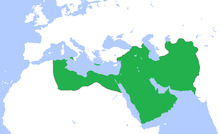
Qatar was described as a famous horse and camel breeding centre during the Umayyad period.[54] In the 8th century, it started benefiting from its commercially strategic position in the Persian Gulf and went on to become a centre of pearl trading.[55][56] Substantial development in the pearling industry around the Qatari Peninsula occurred during the Abbasid era.[54] Ships voyaging from Basra to India and China would make stops in Qatar's ports during this period. Chinese porcelain, West African coins, and artefacts from Thailand have been discovered in Qatar.[53] Archaeological remains from the 9th century suggest that Qatar's inhabitants used greater wealth to construct higher quality homes and public buildings. Over 100 stone-built houses, two mosques, and an Abbasid fort were constructed in Murwab during this period.[57][58] When the caliphate's prosperity declined in Iraq, so too did it in Qatar.[59] Qatar is mentioned in 13th-century Muslim scholar Yaqut al-Hamawi's book, Mu'jam Al-Buldan, which alludes to the Qataris' fine striped woven cloaks and their skills in improvement and finishing of spears.[60]
Much of eastern Arabia was controlled by the Usfurids in 1253, but control of the region was seized by the prince of Ormus in 1320.[61] Qatar's pearls provided the kingdom with one of its main sources of income.[62] In 1515, Manuel I of Portugal vassalised the Kingdom of Ormus. Portugal went on to seize a significant portion of eastern Arabia in 1521.[62][63] In 1550, the inhabitants of Al-Hasa voluntarily submitted to the rule of the Ottomans, preferring them to the Portuguese.[64]
Portuguese era
After the fall of the Jabrid Dynasty with the conquest of Bahrain by the Portuguese, the Arabian coast up to Al Hassa came under the rule and influence of the Portuguese empire. Attempts by the Ottomans to dominate the region were eliminated with the reconquest of the castle of Tarout[65] or Al Qatif in 1551.
Archaeological finds are still being excavated from one of the Portuguese fortresses that served as a base to dominate the region as Ruwayda.[66] The first representation of Qatar appears on the Portuguese map by Luis Lázaro in 1563, showing the "city of Qatar" as a fortress.[67] Having retained a negligible military presence in the area, the Ottomans were expelled by the Bani Khalid tribe and their emirate in 1670.[68]
Bahraini and Saudi rule (1783–1868)

In 1766, members of the Al Khalifa family of the Utub tribal confederation migrated from Kuwait to Zubarah in Qatar.[69][70] By the time of their arrival, the Bani Khalid exercised weak authority over the peninsula, notwithstanding the fact that the largest village was ruled by their distant kin.[71] In 1783, Qatar-based Bani Utbah clans and allied Arab tribes invaded and annexed Bahrain from the Persians. The Al Khalifa imposed their authority over Bahrain and retained their jurisdiction over Zubarah.[69]
Following his swearing-in as crown prince of the Wahhabi in 1788, Saud ibn Abd al-Aziz moved to expand Wahhabi territory eastward towards the Persian Gulf and Qatar. After defeating the Bani Khalid in 1795, the Wahhabi were attacked on two fronts. The Ottomans and Egyptians assaulted the western front, while the Al Khalifa in Bahrain and the Omanis launched an attack against the eastern front.[72][73] Upon being made aware of the Egyptian advance on the western frontier in 1811, the Wahhabi amir reduced his garrisons in Bahrain and Zubarah in order to redeploy his troops. Said bin Sultan, ruler of Muscat, capitalised on this opportunity and raided the Wahhabi garrisons on the eastern coast, setting fire to the fort in Zubarah. The Al Khalifa was effectively returned to power thereafter.[73]
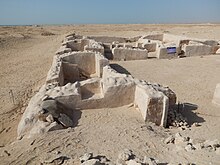
As punishment for piracy, an East India Company vessel bombarded Doha in 1821, destroying the town and forcing hundreds of residents to flee. In 1825, the House of Thani was established with Sheikh Mohammed bin Thani as the first leader.[74]
Although Qatar was considered a dependency of Bahrain, the Al Khalifa faced opposition from the local tribes. In 1867, the Al Khalifa, along with the ruler of Abu Dhabi, sent a massive naval force to Al Wakrah in an effort to crush the Qatari rebels. This resulted in the maritime Qatari–Bahraini War of 1867–68, in which Bahraini and Abu Dhabi forces sacked and looted Doha and Al Wakrah.[75] The Bahraini hostilities were in violation of the Perpetual Truce of Peace and Friendship of 1861. The joint incursion, in addition to the Qatari counter-attack, prompted British Political Resident, Colonel Lewis Pelly to impose a settlement in 1868. His mission to Bahrain and Qatar and the resulting peace treaty were milestones because they implicitly recognised the distinctness of Qatar from Bahrain and explicitly acknowledged the position of Mohammed bin Thani. In addition to censuring Bahrain for its breach of agreement, Pelly negotiated with Qatari sheikhs who were represented by Mohammed bin Thani.[76] The negotiations were the first stage in the development of Qatar as a sheikhdom.[77]
Ottoman period (1871–1915)
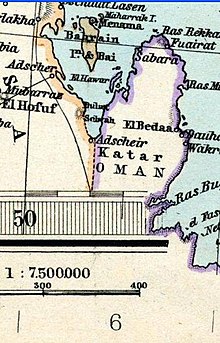

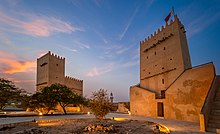
Under military and political pressure from the governor of the Ottoman Vilayet of Baghdad, Midhat Pasha, the ruling Al Thani tribe submitted to Ottoman rule in 1871.[78] The Ottoman government imposed reformist (Tanzimat) measures concerning taxation and land registration to fully integrate these areas into the empire.[78] Despite the disapproval of local tribes, Al Thani continued supporting the Ottoman rule. Qatari-Ottoman relations stagnated, and in 1882 they suffered further setbacks when the Ottomans refused to aid Al Thani in his expedition of Abu Dhabi-occupied Khawr al Udayd. In addition, the Ottomans supported the Ottoman subject Mohammed bin Abdul Wahab who attempted to supplant Al Thani as kaymakam of Qatar in 1888.[79] This eventually led Al Thani to rebel against the Ottomans, whom he believed were seeking to usurp control of the peninsula. He resigned as kaymakam and stopped paying taxes in August 1892.[80]
In February 1893, Mehmed Hafiz Pasha arrived in Qatar in the interests of seeking unpaid taxes and accosting Jassim bin Mohammed's opposition to proposed Ottoman administrative reforms. Fearing that he would face death or imprisonment, Jassim retreated to Al Wajbah (16 km or 10 mi west of Doha), accompanied by several tribe members. Mehmed's demand that Jassim disband his troops and pledge his loyalty to the Ottomans was met with refusal. In March, Mehmed imprisoned Jassim's brother and 13 prominent Qatari tribal leaders on the Ottoman corvette Merrikh as punishment for his insubordination. After Mehmed declined an offer to release the captives for a fee of 10,000 liras, he ordered a column of approximately 200 troops to advance towards Jassim's Al Wajbah Fort under the command of Yusuf Effendi, thus signalling the start of the Battle of Al Wajbah.[53]
Effendi's troops came under heavy gunfire by a sizable troop of Qatari infantry and cavalry shortly after arriving at Al Wajbah. They retreated to Shebaka fortress where they were again forced to draw back from a Qatari incursion. After they withdrew to Al Bidda fortress, Jassim's advancing column besieged the fortress, resulting in the Ottomans' concession of defeat and agreement to relinquish their captives in return for the safe passage of Mehmed Pasha's cavalry to Hofuf by land.[81] Although Qatar did not gain full independence from the Ottoman Empire, the result of the battle forced a treaty that would later form the basis of Qatar's emerging as an autonomous country within the empire.[82]
British period (1916–1971)

By the Anglo-Ottoman Convention of 1913, the Ottomans agreed to renounce their claim to Qatar and withdraw their garrison from Doha. However, with the outbreak of World War I, nothing was done to carry this out, and the garrison remained in the fort at Doha, although its numbers dwindled as men deserted. In 1915, with the presence of British gunboats in the harbour, Abdullah bin Jassim Al Thani (who was pro-British) persuaded the remainder to abandon the fort, and when British troops approached the following morning they found it deserted.[83][84]
Qatar became a British protectorate on 3 November 1916[85] when the United Kingdom signed a treaty with Sheikh Abdullah bin Jassim Al Thani to bring Qatar under its Trucial System of Administration. The treaty reserved foreign affairs and defence to the United Kingdom but allowed internal autonomy. While Abdullah agreed not to enter into any relations with any other power without the prior consent of the British government, the latter guaranteed the protection of Qatar from aggression by sea and provide its 'good offices' in the event of an attack by land. This latter undertaking was left deliberately vague.[83][86]
On 5 May 1935, while agreeing an oil concession with the Anglo-Persian Oil Company, Abdullah signed another treaty with the British government which granted Qatar protection against internal and external threats.[83] Oil reserves were first discovered in 1939. Exploitation and development were, however, delayed by World War II.[87]

The focus of British interests in Qatar changed after the Second World War with the independence of India, the creation of Pakistan in 1947, and the development of oil in Qatar. In 1949, the appointment of the first British political officer in Doha, John Wilton, signified a strengthening of Anglo-Qatari relations.[88] Oil exports began in 1949, and oil revenues became the country's main source of revenue; the pearl trade had gone into decline. These revenues were used to fund the expansion and modernisation of Qatar's infrastructure.
When Britain officially announced in 1968 that it would withdraw from the Persian Gulf in three years' time, Qatar joined talks with Bahrain and seven other Trucial States to create a federation. Regional disputes, however, persuaded Qatar and Bahrain to withdraw from the talks and become independent states separate from the Trucial States, which went on to become the United Arab Emirates.
Independence and later (1971–2000)
Under an agreement with the United Kingdom,[89][90] on 3 September 1971, the "special treaty arrangements" that were "inconsistent with full international responsibility as a sovereign and independent state" were terminated.[90]

In 1991, Qatar played a significant role in the Gulf War, particularly during the Battle of Khafji in which Qatari tanks rolled through the streets of the town and provided fire support for Saudi Arabian National Guard units that were engaging Iraqi Army troops. Qatar allowed coalition troops from Canada to use the country as an airbase to launch aircraft on combat air patrol duty and also permitted air forces from the United States and France to operate in its territories.[40]
In 1995, Emir Hamad bin Khalifa Al Thani seized control of the country from his father Khalifa bin Hamad Al Thani, with the support of the armed forces and cabinet, as well as neighbouring states[91] and France.[92] Under Emir Hamad, Qatar experienced a moderate degree of liberalisation, including the launch of the Al Jazeera television station (1996), the endorsement of women's suffrage or right to vote in municipal elections (1999), drafting its first written constitution (2005) and inauguration of a Roman Catholic church (2008).[citation needed]
21st century
Qatar's economy and status as a regional power rapidly grew in the 2000s. According to the UN, the nation's economic growth, measured by GDP, was the fastest in the world during this decade.[93][94] The basis of this growth lay in the exploitation of natural gas in the North Field during the 1990s. At the same time, the population tripled between 2001 and 2011, mostly from an influx of foreigners.[95]
In 2003, Qatar served as the United States Central Command headquarters and one of the main launching sites of the invasion of Iraq.[96] In March 2005, a suicide bombing killed a British teacher[97] at the Doha Players Theatre, shocking the country, which had not previously experienced acts of terrorism. The bombing was carried out by Omar Ahmed Abdullah Ali, an Egyptian resident in Qatar who had suspected ties to Al-Qaeda in the Arabian Peninsula.[98][99] The increased influence of Qatar and its role during the Arab Spring, especially during the Bahraini uprising in 2011, worsened longstanding tensions with Saudi Arabia, the neighboring United Arab Emirates, and Bahrain.[citation needed]
In 2010, Qatar won the right to host the 2022 FIFA World Cup, making it the first country in the Middle East to be selected to host the tournament. The awarding increased further investment and developments within the nation during the 2010s.[100] In June 2013, Sheikh Tamim bin Hamad Al Thani became the emir of Qatar after his father handed over power.[101] Sheikh Tamim has prioritised improving the domestic welfare of citizens, which includes establishing advanced healthcare and education systems, and expanding the country's infrastructure in preparation for the hosting of the 2022 World Cup.[102] Qatar hosted the 2022 FIFA World Cup from 21 November to 18 December, becoming the first Arab and Muslim-majority country to do so, and the third Asian country to host it following the 2002 FIFA World Cup in Japan and South Korea.[103]
Politics
Qatar is officially a semi-constitutional monarchy,[104][105] but the wide powers retained by the monarchy have it bordering an absolute monarchy[106][107] ruled by the Al Thani family.[108][109] The Al Thani dynasty has been ruling Qatar since the family house was established in 1825.[3] In 2003, Qatar adopted a constitution that provided for the direct election of 30 of the 45 members of a legislature.[3][110][111] The constitution was overwhelmingly approved in a referendum, with almost 98% in favour.[112][113] Despite this, the government remains authoritarian.[114][6] According to the V-Dem Democracy indices Qatar is 2023 the second least electoral democratic country in the Middle East.[115] Qatari law does not permit the establishment of political bodies or trade unions.[116]
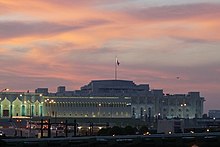
The eighth emir of Qatar is Tamim bin Hamad Al Thani.[117] The emir has the exclusive power to appoint the prime minister and cabinet ministers who, together, constitute the Council of Ministers, which is the supreme executive authority in the country.[118] The Council of Ministers also initiates legislation.[118]
The Consultative Assembly is made up of 30 popularly-elected members and 15 appointed by the emir. It can block legislation with a simple majority and can dismiss ministers, including the prime minister, with a two-thirds vote. The assembly had its first elections in October 2021 after several postponements.[119][120][121]
Law
According to Qatar's Constitution, Sharia law is the main source of Qatari legislation,[122][123] although in practice Qatar's legal system is a mixture of civil law and Sharia.[124][125] Sharia is applied to family law, inheritance, and several criminal acts (including adultery, robbery, and murder). In some cases, Sharia-based family courts treat a female's testimony as being worth half that of a man.[126] Codified family law was introduced in 2006. Islamic polygyny is permitted.[92]
Judicial corporal punishment is a punishment in Qatar. Only Muslims considered medically fit are liable to have such sentences carried out. Flogging is employed as a punishment for alcohol consumption or illicit sexual relations.[127] Article 88 of the criminal code declares that the penalty for adultery is 100 lashes.[128] Stoning is a legal punishment in Qatar,[129] and apostasy and homosexuality are crimes punishable by the death penalty; however, the penalty has not been carried out for either crime.[130][131] Blasphemy can result in up to seven years in prison, while proselytising can incur a 10-year sentence.[130][132]
Alcohol consumption is partially legal; some five-star luxury hotels are allowed to sell alcohol to non-Muslim customers.[133][134] Muslims are not allowed to consume alcohol, and those caught consuming it are liable to flogging or deportation. Non-Muslim expatriates can obtain a permit to purchase alcohol for personal consumption. The Qatar Distribution Company (a subsidiary of Qatar Airways) is permitted to import alcohol and pork; it operates the only liquor store in the country, which also sells pork to holders of liquor licences.[135][136] Qatari officials had indicated a willingness to allow alcohol in "fan zones" at the 2022 FIFA World Cup.[137] However, on 18 November, two days before the start of the games, Qatari officials announced alcoholic beverages would not be permitted within the stadiums.[138]
In 2014, a modesty campaign was launched to remind tourists of the country's restrictive dress code.[139] Female tourists were advised not to wear leggings, miniskirts, sleeveless dresses, or short or tight clothing in public. Men were warned against wearing shorts and singlets.[140]
Foreign relations

Qatar's international profile and active role in international affairs have led some analysts to identify it as a middle power. Since 2022, it has been a major non-NATO ally of the United States.[141] Qatar also has particularly strong ties with France,[142] China,[143] Iran,[144] Turkey,[145] as well as a number of Islamist movements in the Middle East such as the Muslim Brotherhood.[146][147][148] The country is an early member of OPEC and a founding member of the Gulf Cooperation Council, as well as a member of the Arab League.[3] Diplomatic missions to Qatar are based in its capital, Doha.
Regional relations and foreign policies are characterized by the strategy of balancing and alliance building among regional and great powers. It maintains independent foreign policy and engages in regional balancing to secure its strategic priorities and to have recognition on the regional and international level.[147][149][150] As a comparatively small state in the gulf, Qatar established an "open-door" foreign policy where Qatar maintains ties to all parties and regional players in the region.[151]
In 2011, Qatar joined NATO operations in Libya and reportedly armed Libyan opposition groups.[152] It was also a major funder of weapons for rebel groups in the Syrian civil war.[153] Qatar participated in the Saudi Arabian-led intervention in Yemen against the Houthis and forces loyal to former President Ali Abdullah Saleh.[154] Since the 2000s, Qatar increasingly emerged on a wider foreign policy stage especially as a mediator, such as for Middle Eastern conflicts;[155] for example, Qatar mediated between the rival Palestinian factions Fatah and Hamas in 2006[156] and helped unite Lebanese leaders into forming a political agreement during the 2008 crisis.[157] Qatar has also emerged as mediators in African and Asian affairs, notably holding a peace process for Sudan amid the Darfur conflict[158] and facilitating peace talks for Afghanistan, setting up a political "office" for the Afghan Taliban to facilitate talks. Ahmed Rashid, writing in the Financial Times, stated that through the office Qatar has "facilitated meetings between the Taliban and many countries and organisations, including the US state department, the UN, Japan, several European governments and non-governmental organisations, all of whom have been trying to push forward the idea of peace talks."[159] It played a major role in establishing the first ceasefire in the 2023 Israel-Hamas war and the concurrent initial hostage exchange. These high-risk diplomatic middle man endeavors (and its own rigorous defense stance) have thus earned it a reputation as "a prickly Switzerland".[160]

In June 2017, Saudi Arabia, the UAE, Bahrain, Egypt and Yemen broke diplomatic ties with Qatar, accusing Qatar of supporting terrorism.[161] The crisis escalated a dispute over Qatar's support of the Muslim Brotherhood, which is considered a terrorist organization by some Arab nations.[162] The diplomatic crisis ended in January 2021 with the signing of AlUla declaration.[163]
On 2 October 2020, Qatari authorities strip-searched 13 Australian women on a plane at Hamad International Airport over a premature baby found in a bathroom at the terminal. This caused an international incident with Australia.[164][165] In September 2023, Qatar mediated the US- Iran prisoners swap deal. Iran freed five Americans in exchange for five Iranians held in the US and transfer $6 billion in frozen Iranian money from South Korea to Qatar.[166] In October 2023 United States President Joe Biden thanked the Qatar's Sheikh Tamim bin Hamad Al Thani for his help in mediating a landmark prisoner swap deal with Iran.[167]
On 7 October 2023, Hamas started an extensive armed conflict with Israel. Due to its escalation, on 9 October, Qatar’s PM and FM Sheikh Mohammed bin Abdulrahman bin Jassim Al Thani made urgent talks to attempt to arrange the release of 36 Palestinian women and children detained in Israeli prisons in exchange for the release of Israeli women and children held by the militant group that were taken hostage and kidnapped into Gaza.[168]
On 1 November 2023, Qatar mediated an agreement between Egypt, Israel, and Hamas. This agreement, which was coordinated with the U.S., enabled evacuation of civilians from besieged Gaza.[169][170] Sheikh Mohammed met with CIA Director William J. Burns and head of Mossad David Barnea in Qatar in November. [171][172]They reached an extension of the ceasefire by two days and exchange of more than 100 Israeli hostages for 240 Palestinian prisoners.[173][174][175]
In late January 2024, Sheikh Mohammed met US officials in an effort to continue ceasefire negotiations in Washington, D.C.,[176] and welcomed US Secretary Blinken in Doha on 6 February 2024.[177] With Qatar and Egypt as mediators, Hamas proposed a deal which would include the release of all Israeli hostages in Gaza and hundreds of Palestinians held in Israeli prisons, and an end to the war.[178] On 7 February 2024, Israeli Prime Minister Netanyahu rejected the proposal.[179]
The humanitarian efforts by Mohammed bin Abdulrahman bin Jassim Al Thani and Emir Tamim Bin Hamad Al Thani were praised by various global leaders such as US Secretary Antony Blinken, Canadian prime minister Justin Trudeau, US President Joe Biden and the EU's high representative for foreign affairs Josep Borrell.[180][181]
The TIME magazine, has recognized Sheikh Mohammed bin Abdulrahman bin Jassim Al Thani as one of the "100 Most Influential People" in the world for the year 2024. According to the magazine, Sheikh Mohammed's inclusion in the list is attributed to his notable role in the negotiations between Hamas and Israel.
Sheikh Mohammed bin Abdulrahman bin Jassim Al Thani has been instrumental in leading the negotiations, which have led to a temporary ceasefire and the successful release of more than 100 hostages. The TIME magazine recognizes Qatar's adeptness in managing diverse interests, exemplified by its hosting of a significant US air base and a Taliban office. The decision was further shaped by the Prime Minister's role as a mediator in various regions grappling with difficulties, including South America. "Moreover, before October 7, the 43-year-old prime minister had received commendation from US officials for his adeptness as a mediator in numerous complex scenarios, including those in South America," it stated.[182]
Military
The Qatar Armed Forces consist of 12,000 personnel in the Qatari Emiri Land Forces, 2,500 in the Navy, 2,000 in the Air Force, and 5,000 in the Internal Security Forces.[183] In 2008 Qatar spent US$2.3 billion on its military, which was 2.3% of the GDP,[184] and its military spending increased to US$7.49 billion as of 2022.[183] After the Arab spring events in 2011 and a diplomatic incident with Saudi Arabia and other Gulf countries in 2014, Qatar started expanding its armed forces.[185] The country introduced conscription in 2013, the first Gulf state to do so in recent years. It is mandatory for Qatari male citizens to serve for up to 4 months, though not all of them are called up. The national service term was extended to one year in 2018. About 2,000 conscripts pass through the Qatar Armed Forces annually. Military service has become more popular in Qatar due to the recent tensions with Saudi Arabia and the UAE.[186][187] Since 2017, Qatar has also purchased large quantities of equipment from European countries and the United States, making its air force one of the largest among the Gulf states.[183][185]
The Stockholm International Peace Research Institute (SIPRI) found that in 2010–2014 Qatar was the 46th-largest arms importer in the world. SIPRI writes that Qatar's plans to transform and significantly enlarge its armed forces have accelerated.[188] In 2015, Qatar was the 16th largest arms importer in the world, and in 2016, it was the 11th largest, according to SIPRI.[189]
Qatar has signed defense pacts with the United States, the United Kingdom, and France.[190] The forward headquarters of United States Central Command, Al Udeid Air Base, is located in Qatar and houses about 10,000 American military personnel.[185]
During the 2011 military intervention in Libya, Qatar deployed six Mirage 2000 fighter jets to assist the NATO air campaign against the Libyan government and special forces to provide training to Libyan rebels.[191] Since the start of Saudi-led intervention in the Yemeni civil war, by September 2015 Qatar sent 1,000 troops, 200 armored vehicles, and 30 Apache helicopters to assist Saudi Arabia with its military operations in Yemen.[192][193] In June 2017, at the start of the diplomatic crisis with Saudi Arabia, Qatar withdrew its forces from Yemen.[194]
Human rights
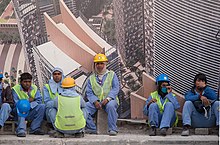
Qatar's human rights record has been regarded by academics and non-governmental organisations as being generally poor, with restrictions on civil liberties such as the freedoms of association, expression and the press, as well as its treatment of thousands of migrant workers amounting to forced labour for projects in the country.[195][196]
In May 2012, Qatari officials declared their intention to allow the establishment of an independent trade union.[197] In 2014, Qatar commissioned international law firm DLA Piper to produce a report investigating the immigrant labour system. In May 2014, DLA Piper released more than 60 recommendations for reforming the kafala system including the abolition of exit visas and the introduction of a minimum wage, which Qatar has pledged to implement. Qatar also announced it would scrap its sponsor system for foreign labour, which requires that all foreign workers be sponsored by local employers.[198]
The UN Committee Against Torture found that the provisions for flogging and stoning within the Qatari criminal code constituted a breach of the obligations imposed by the UN Convention Against Torture.[199][200] Homosexual acts are illegal and can be punished by death.[201] However, there is no such evidence that the death penalty has been given for same-sex relations due to homosexual acts.[202]
Under the provisions of Qatar's sponsorship law, sponsors had the unilateral power to cancel workers' residency permits, deny workers' ability to change employers, report a worker as "absconded" to police authorities, and deny permission to leave the country.[203] As a result, sponsors may restrict workers' movements, and workers may be afraid to report abuses or claim their rights.[203] According to the ITUC, the visa sponsorship system allows the exaction of forced labour by making it difficult for a migrant worker to leave an abusive employer or travel overseas without permission.[204] Qatar also did not maintain wage standards for its immigrant labourers. Additional changes to labour laws include a provision guaranteeing that all workers' salaries are paid directly into their bank accounts and new restrictions on working outdoors in the hottest hours during the summer.[205]
In 2016 laws were reformed to mandate that companies that fail to pay workers' wages on time could temporarily lose their ability to hire more employees.[206][207] Human Rights Watch claimed that the changes might fail to address some labour rights issues.[208][209] A minimum wage was instituted in 2021.[210] The country enfranchised women at the same time as men in connection with the 1999 elections for a Central Municipal Council.[110][211] These elections—the first-ever in Qatar—were intentionally held on 8 March 1999, International Women's Day.[110]
Administrative divisions
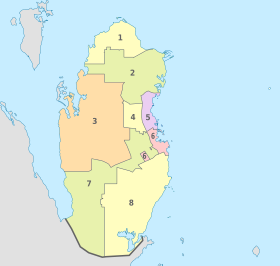
Qatar is divided into eight municipalities (Arabic: baladiyah).[212]
For statistical purposes, the municipalities are further subdivided into 98 zones,[213] which are in turn subdivided into blocks.[214]
Former municipalities
- Al Jemailiya (until 2004)[215]
- Al Ghuwariyah (until 2004)[215]
- Jariyan al Batnah (until 2004)[215]
- Mesaieed (Umm Sa'id) (until 2006)[216]
Geography
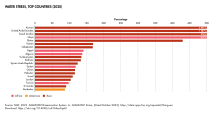
The Qatari peninsula protrudes 160 kilometres (100 mi) into the Persian Gulf, north of Saudi Arabia. It lies between latitudes 24° and 27° N, and longitudes 50° and 52° E. Most of the country consists of a low, barren plain, covered with sand. To the southeast lies the Khor al Adaid ("Inland Sea"), an area of rolling sand dunes surrounding an inlet of the Persian Gulf.
The highest point is Qurayn Abu al Bawl at 103 metres (338 ft)[3] in the Jebel Dukhan to the west, a range of low limestone outcroppings running north–south from Zikrit through Umm Bab to the southern border. The Jebel Dukhan area also contains Qatar's main onshore oil deposits, while the natural gas fields lie offshore, to the northwest of the peninsula.[citation needed]
Biodiversity
Qatar became part of the Rio Convention on Biological Diversity in 1996.[217] It subsequently produced a National Biodiversity Strategy and Action Plan in 2005.[218] A total of 142 fungal species have been recorded from Qatar.[219] A book recently produced by the Ministry of Environment documents the lizards known or believed to occur in Qatar, based on surveys conducted by an international team of scientists and other collaborators.[220]
According to the Emissions Database for Global Atmospheric Research, carbon dioxide emissions per person average over 30 tonnes, one of the highest in the world.[221]
Climate
| Climate data for Qatar | |||||||||||||
|---|---|---|---|---|---|---|---|---|---|---|---|---|---|
| Month | Jan | Feb | Mar | Apr | May | Jun | Jul | Aug | Sep | Oct | Nov | Dec | Year |
| Mean daily maximum °C (°F) | 22 (72) |
23 (73) |
27 (81) |
33 (91) |
39 (102) |
42 (108) |
42 (108) |
42 (108) |
39 (102) |
35 (95) |
30 (86) |
25 (77) |
33 (92) |
| Mean daily minimum °C (°F) | 14 (57) |
15 (59) |
17 (63) |
21 (70) |
27 (81) |
29 (84) |
31 (88) |
31 (88) |
29 (84) |
25 (77) |
21 (70) |
16 (61) |
23 (74) |
| Average precipitation mm (inches) | 12.7 (0.50) |
17.8 (0.70) |
15.2 (0.60) |
7.6 (0.30) |
2.5 (0.10) |
0 (0) |
0 (0) |
0 (0) |
0 (0) |
0 (0) |
2.5 (0.10) |
12.7 (0.50) |
71 (2.8) |
| Source: "Doha Annual Weather Averages". World Weather Online. Retrieved 24 December 2022. | |||||||||||||



